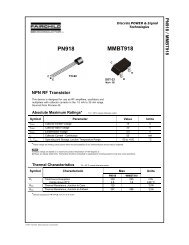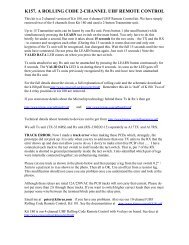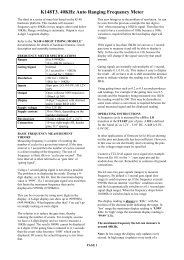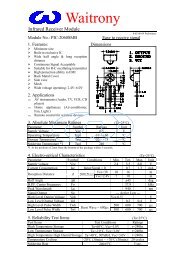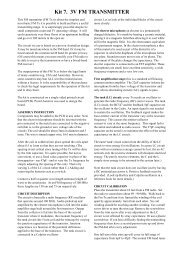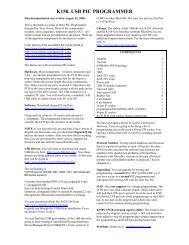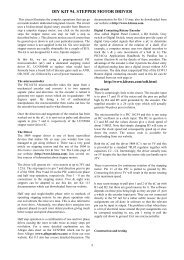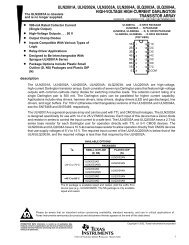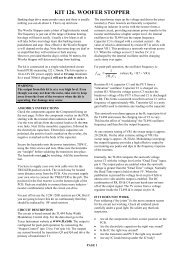DIY Kit 127. 3 ½ Digit LCD Digital Panel Meter - PAiA
DIY Kit 127. 3 ½ Digit LCD Digital Panel Meter - PAiA
DIY Kit 127. 3 ½ Digit LCD Digital Panel Meter - PAiA
You also want an ePaper? Increase the reach of your titles
YUMPU automatically turns print PDFs into web optimized ePapers that Google loves.
<strong>DIY</strong> <strong>Kit</strong> <strong>127.</strong> 3 ½ <strong>Digit</strong> <strong>LCD</strong> <strong>Digit</strong>al <strong>Panel</strong> <strong>Meter</strong><br />
The 7106 chip is one of the long term survivors in the IC<br />
world. It was launched in 1977 yet it has remained as<br />
popular as ever.<br />
The reason is that it contains in it all the active circuitry<br />
for a 3 1/2 digit panel meter (DPM) in a single chip. It<br />
was designed to interface directly to a liquid crystal<br />
display (<strong>LCD</strong>). (It has a sister chip, the 7107, intended for<br />
connection to light emitting diode displays.) So the chip<br />
contains BCD to seven segment decoders, display drivers,<br />
clock and a reference voltage as well as the necessary<br />
analog to digital (a/d) circuitry to convert the input<br />
voltage to a digital form. The a/d system also indicates the<br />
polarity of the input voltage.<br />
Voltage is the most frequently measured electrical<br />
quantity. In temperature meters, current meters, wind<br />
speed meters and resistance meters what is actually being<br />
measured is voltage, or more correctly, the potential<br />
difference between two points. After calibrating the meter<br />
for its particular purpose then the potential difference<br />
measured will give an accurate digital reading of the<br />
analog quantity being measured.<br />
With a few additional external passive components the<br />
7106 chip may be made into an easy to use meter for any<br />
of these purposes especially multiple range digital volt<br />
meters.<br />
<strong>Digit</strong>al meters have many advantages over analog meters<br />
that use a pointer and moving coil.<br />
1. They are easier to read. In the majority of<br />
applications it is better that the value displayed is<br />
exactly the value being measured, for example,<br />
13.6V. To use an analog display with its many<br />
graduated scales (some going up and others going<br />
down) and switches requires considerable practice.<br />
But a simple <strong>LCD</strong> which reads '13.6' can be<br />
understood by everyone.<br />
2. DPMs built using the 7106 are physically stronger<br />
and more robust than analog meters because they<br />
have no moving parts.<br />
3. The 7106 by its very nature can be adapted to so<br />
many uses at such a low cost that it has actually<br />
created markets for itself.<br />
All of these factors add up to a better, cheaper product<br />
which everyone can afford.<br />
In this <strong>Kit</strong> we have supplied the 7106, the <strong>LCD</strong> and the<br />
essential components and information necessary for you to<br />
custom build it into a panel meter of your choice. The<br />
PCB has a printed overlay on it so that the position of all<br />
the components is clearly indicated and construction only<br />
takes a few minutes.<br />
The kit is constructed on a double-sided, through hole<br />
plated printed circuit board (PCB). Protel Autotrax and<br />
Schematic were used to design it.<br />
ASSEMBLY INSTRUCTIONS<br />
Assembly is generally straightforward. Follow the overlay<br />
to tell you where to put the components. Leave resistors<br />
RA and RB until last.<br />
Start by inserting all the resistors first, followed by the<br />
capacitors. Capacitors C1, C4 and C5 are mounted under<br />
the IC so make sure they are pushed down close to the<br />
PCB. Next comes the 40 pin IC socket for the 7106. Once<br />
again be sure it is pushed right down before soldering.<br />
The <strong>LCD</strong> is mounted on two 20 pin socket strips. These<br />
are made by cutting apart a 40 pin IC socket using your<br />
side cutters. This allows the <strong>LCD</strong> to sit above the 7106<br />
chip. Take care that these strips are at right angles to the<br />
PCB otherwise inserting the <strong>LCD</strong> will be difficult.<br />
Trimpot P1 can be fitted to either side of the PCB. Putting<br />
it on the rear (solder side) of the PCB makes it easier to<br />
adjust if the meter is mounted on a panel.<br />
Lastly insert the 7106 into its socket, followed by the<br />
<strong>LCD</strong>. Make sure you get them round the correct way. A<br />
small triangle on the overlay marks pin 1 of each part.<br />
All that remains is to determine the values of RA and RB<br />
(described later) and soldering them in, along with a link<br />
for the decimal point position if required. For the moment<br />
just solder a link for RB.<br />
CALIBRATION<br />
Connect 9V to the kit. All that remains is calibration. This<br />
is easy. Connect a multimeter between pins 35 and 36 of<br />
the 7106. Use alligator clips on the solder side of the<br />
board. Use trimpot P1 to adjusted VREF measured<br />
between these pins to 100mV.<br />
(You can also do this another way by applying a known<br />
voltage to the input terminals and adjusting VREF for the<br />
this reading so that VIN = 2 x VREF. This requires that RA<br />
and RB are installed.)<br />
Now decide the input voltage range you want to measure<br />
according to the table on the next page.<br />
WHAT TO DO IF IT DOES NOT WORK<br />
Poor soldering is the most likely reason. Check all solder<br />
joints carefully under a good light. Check that all<br />
components are in their correct position on the PCB.<br />
Are the IC and <strong>LCD</strong> in the correct way. Check no pins are<br />
bent up. This is very easy to do with a 40 pin IC and the<br />
<strong>LCD</strong> display.<br />
Is the battery flat?<br />
CIRCUIT DESCRIPTION<br />
The heart of the meter is the A/D converter built into the<br />
7106. It uses a dual slope conversion technique. It relies<br />
on the charging and discharging of an integrating<br />
capacitor and having a counter count when the capacitor<br />
voltage is above a set value. Since the capacitor discharge<br />
PAGE 1
<strong>DIY</strong> <strong>Kit</strong> <strong>127.</strong> 3 ½ <strong>Digit</strong> <strong>LCD</strong> <strong>Digit</strong>al <strong>Panel</strong> <strong>Meter</strong><br />
is linear the counter reading is proportional to the input<br />
voltage. There are three phases to the process:<br />
Phase 1 - Auto Zero.<br />
The auto zero capacitor is charged to the integrator’s<br />
offset voltage. This voltage is subtracted from the input<br />
signal during phase 2. The integrator thus appears to have<br />
zero offset voltage.<br />
Phase 2 - Signal Integrate.<br />
The signal input is averaged for 1000 clock pulses.<br />
Phase 3 - Reference Integrate.<br />
VREF is averaged back to zero volts. The number of clock<br />
pulses counted to return to zero is a digital measure of<br />
VIN.<br />
Reference Voltage. The analog input required to generate<br />
a full scale output of 2000 counts is<br />
VIN = 2 x VREF<br />
Thus to set the meter to read from 0 - 199.9mV VREF is<br />
set to 100.0mV.<br />
VREF is measured between pins 35 & 36. The trimpot, P1,<br />
is adjusted to get the correct reference voltage.<br />
To measure voltage greater than 200mV an input voltage<br />
divider is required (see Figure 4). The general relation for<br />
full scale sensitivity is now:<br />
The Reference Voltage supplied to the 7106 at pins 35<br />
and 36 should be between 100mV and 1V for most<br />
purposes. This corresponds to a full scale reading of<br />
199.9mV and 1.999V respectively. In this kit VREF is set<br />
to 100mV but is adjustable from 89 - 107mV.<br />
Let us discuss parts of the circuit in more detail and<br />
investigate how to customize the meter for your purpose.<br />
Decimal Point. A jumper selects the decimal point<br />
position in the <strong>LCD</strong>. Displays are driven by applying a<br />
symmetrical square wave to the back plane (BP.) To turn<br />
on a segment a waveform 180° out of phase with the BP<br />
(but of equal amplitude) is applied to that segment. To get<br />
the decimal point the external circuit inverts the<br />
BP output (pin 21) with a transistor and applies it to the<br />
required decimal via a jumper. Pin 37 is used as the<br />
negative supply for these externally generated segment<br />
drivers.<br />
Analog Section. C1 is the reference capacitor and is<br />
unchanged for all ranges measured. INLO is tied to the<br />
analog COMMON pin 32.<br />
The integration capacitor C5 is suitable for VREF values<br />
but the value of the integration resistor R1 should be<br />
increased to 470K for a VREF of 1V.<br />
System Timing. This is determined by the components<br />
connected to pins 38, 39 & 40. Values are unchanged for<br />
all ranges measured. The internal oscillator runs at 48kHz,<br />
or 3 readings per second.<br />
Auto-Zero Capacitor. This is C4 connected to pin 29. It<br />
has some influence on the noise of the system and<br />
recovery from overload input. For 200mV full scale a<br />
0.47uF capacitor is recommended.<br />
VIN (full scale) = 2 x VREF x RA / (RA + RB)<br />
Figure 4. Input Attenuation for VIN > 200mV<br />
For example, a 0 - 20V range can be obtained using a<br />
100:1 voltage divider. This can be done by making RA =<br />
300K and RB = 2.7M. The decimal point jumper is placed<br />
at position '2' so a full scale display of 19.99V is<br />
available. The following table shows the resistor values to<br />
use for different voltage ranges and the position of the<br />
decimal point jumper.<br />
Range RA RB DP jumper<br />
200mV 10M Wire Link 2<br />
2V 300K 2.7M 4<br />
20V 100K 10M 3<br />
200V 10K 10M 2<br />
Note: For the 20V and 200V range RB should be 9.9M<br />
and 9.99M respectively. This introduces a slight error that<br />
can be corrected by adjusting VREF slightly<br />
(CALIBRATION method 2).<br />
The 200mV range does not require a voltage divider on<br />
the input but a 10M resistor is used for RA anyway. The<br />
input resistance of the 7106 is so high that this resistor is<br />
necessary to short out any static charge accumulating on<br />
the input terminals.<br />
PAGE 2
<strong>DIY</strong> <strong>Kit</strong> <strong>127.</strong> 3 ½ <strong>Digit</strong> <strong>LCD</strong> <strong>Digit</strong>al <strong>Panel</strong> <strong>Meter</strong><br />
Putting this all together we can construct a multi range<br />
voltmeter as shown in Figure 5.<br />
If R = 0.1 ohms then 200mV will be developed when the<br />
current through it is 2A. This voltage is applied to the<br />
meter which is set up for the 200mV range. Power<br />
dissipation at the maximum reading is I 2 R.<br />
To measure a full scale of 200mA then R should be 1.0<br />
ohms in order to generate 200mV input to the meter. For a<br />
20 mA meter then R = 10 ohms.<br />
A general multi range current meter is shown in Fig. 7.<br />
Figure 5. Multi range Voltmeter<br />
Non-standard Voltage Input. In many applications it is<br />
required that the output of a transducer is converted by a<br />
scale factor into some meaningful result. For example, a<br />
load cell of a weighing system may have an output voltage<br />
of 0.682V when it has 2.0 Kg weight on it. You want the<br />
meter to read the range 0 - 1.99 Kg directly.<br />
Set the meter (RA and RB) to have a 2V input range. This<br />
gives a maximum input voltage of 68.2mV. Then adjust<br />
VREF to 34.1mV (half the input voltage), put the decimal<br />
point in the correct position by moving the jumper and the<br />
panel meter now reads off 0 - 1.99 Kg directly from the<br />
display.<br />
Voltages Below 200mV. On the 200mV scale the least<br />
significant digit represents 100 micro volts. To resolve<br />
smaller signals it is necessary to use an op-amp prior to<br />
the voltage input to amplify the DC voltage.<br />
Current Measurement. The current must be converted<br />
into a voltage using a shunt resistor. The voltage divider<br />
resistors RA and RB are not used. The principal is shown<br />
in Figure 6.<br />
Figure 7. Multi range Current <strong>Meter</strong><br />
Resistance Measurement. The kit is not specifically<br />
designed for this purpose, however, with some changes to<br />
the board this function can be carried out. The principle is<br />
shown in Fig. 8. The unknown resistance is put in series<br />
with a known resistance and a current is passed through<br />
the pair as shown. If they are of equal value the<br />
integration and de-integration ramps will be of equal slope<br />
and the display will read 1000. The maximum readable<br />
ratio is 1.999. Since a ratio is being measured the<br />
reference resistor need not be exact.<br />
Displayed reading = Runknown / Rstandard x 1000<br />
Figure 6. Principle of Current Measurement<br />
Figure 8. Measuring Resistance<br />
PAGE 3
<strong>DIY</strong> <strong>Kit</strong> <strong>127.</strong> 3 ½ <strong>Digit</strong> <strong>LCD</strong> <strong>Digit</strong>al <strong>Panel</strong> <strong>Meter</strong><br />
WHAT TO LEARN FROM THIS KIT<br />
The <strong>Kit</strong> shows how much of electronics today can be<br />
contained in a single chip. Commercial low to medium<br />
cost digital multimeters are nothing more than this kit,<br />
some switches and passive components and a plastic case.<br />
The main reason today for the failure of meters is more<br />
likely due to switch contact and mechnical failure rather<br />
than failure of the electronics itself.<br />
Web Address & Email<br />
You can email us at peter@kitsrus.com if you have<br />
any problems or requests. See our Web page at:<br />
http://www.kitsrus.com<br />
The data sheet for the 7106 may be downloaded from the<br />
Intersil website at<br />
www.intersil.com<br />
or you can get it from our website at<br />
www.kitsrus.com/pdf/7106.pdf<br />
You can get the pinout information for the <strong>LCD</strong> at<br />
www.kitsrus.com/pdf/vi302_dp.pdf<br />
You may get a detailed Application Note for the 7106 at<br />
www.kitsrus.com/pdf/7106_an1.pdf<br />
PARTS LIST – K127<br />
Resistors (0.25W carbon)<br />
820 grey red brown............. R3 ..................................1<br />
27K red violet orange ........ R2,5,6 ............................3<br />
47K yellow violet orange ... R1 ..................................1<br />
100K brown black yellow.. R4 ..................................1<br />
1M brown black green....... R7 ..................................1<br />
Capacitors<br />
100pF 101 ceramic ............. C3 ..................................1<br />
100nF 104 monobloc......... C1,2 ...............................2<br />
220nF 224 monobloc......... C5 ..................................1<br />
470nF 474 monobloc......... C4 ..................................1<br />
Semiconductors<br />
BC547, NPN transistor....... Q1..................................1<br />
7106 IC............................... IC1.................................1<br />
3 ½ <strong>Digit</strong> <strong>LCD</strong> A/D converter<br />
Miscellaneous<br />
Trimpot, 200Ω.................... P1 ..................................1<br />
Liquid Crystal Display........ <strong>LCD</strong>...............................1<br />
3 ½ digit, VI-302-DP-RC<br />
IC socket, 40 pin.........................................................2<br />
For mounting IC1 and <strong>LCD</strong><br />
9V battery snap...........................................................1<br />
PCB, K127 .................................................................1<br />
PAGE 4



